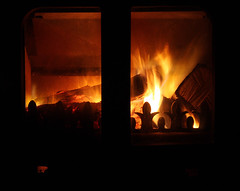 Image by Shandchem via Flickr
Image by Shandchem via Flickr
Here's why:
Airtight woodstoves extract heat from wood in two ways. The primary source of heat from a woodstove is the combustion of the firewood itself: the secondary source is the combustion of the gasified resins and unburned wood particles that result from the primary fire. Unless yours is a very primitive model, you'll find a baffle plate of some kind near the top of your stove, between the fire chamber and the flue outlet. This is where the secondary burn occurs, and where your stove creates up to half the heat it delivers to you.
The amount of secondary combustion that occurs varies widely from model to model, largely due to advances in heat extraction technology over the years; a twelve-year-old baffled airtight can be presumed to operate at about 45% efficiency, while many of today's EPA approved woodstoves exceed 70% efficiency. The big difference between the older woodstoves and today's woodstoves can be found in the baffle area, where newer, more sophisticated techniques have been incorporated to re-burn the exhaust gases.
When you add an unseasoned or wet piece of firewood to your fire, the water contained in the firewood heats up and turns to steam, which mixes with the exhaust gases and extinguishes the secondary burn. Regardless of how sophisticated your baffle system is, this cuts your heat output by up to 50%, and results in cool, water-laden exhaust filled with unburned particles and exhaust gases. This wet, heavy, high-density smoke travels very slowly up the chimney, where it cools even further, condensing onto the walls of the flue and causing excessive creosote formation.
So, when you burn unseasoned or wet firewood, you dramatically DECREASE your heat output, while dramatically INCREASING the likelihood of chimney fires.
Another drawback to burning wet or unseasoned wood is creosote formation on the viewing window. No matter how good the air-wash design that keeps the window clean, it won't work when the firebox is full of wet smoke. A blackened viewing window is one of the most reliable indicators that the firewood is improperly seasoned.
The Draft Control
The draft control is there to enable you to control the combustion of your dry firewood, UP TO A POINT. You can turning the draft control down to control heat output and burn time, but be careful not to smolder the fire. If your stove has a viewing window, you can easily see if you're starving the fire for air; the flames go out. If you don't have a viewing window, attach a flue gas thermometer to the stovepipe, 18" to 24" away from the stove, and keep the flue gas temperature above 325 degrees better still as discussed in a previous post between 400 and 900 degrees (F).
Oxygen is required to ignite the gases in the secondary burn area, so if you take away too much air by adjusting your draft control too low, you'll lose the benefits of the secondary burn even if your wood is dry. This will show itself on the flue gas thermometer, which will quickly fall into the creosote zone.
Today's EPA approved woodstoves provide pre-heated oxygen to the secondary burn chamber directly, through a separate intake controlled by the chimney updraft, enabling you to turn your draft control all the way down to control the primary fire without extinguishing the secondary burn. This technology results in fewer particulate emissions, longer burn times and cleaner chimneys, but it is important to note that steam is still not combustible. Even these state-of-the-art stoves won't burn the gases in the secondary burn chamber if the wood is wet.
Coming Up:
In the next post we will discuss some of the tips to get and keep your fire wood dry.
Related Posts:
;-)

